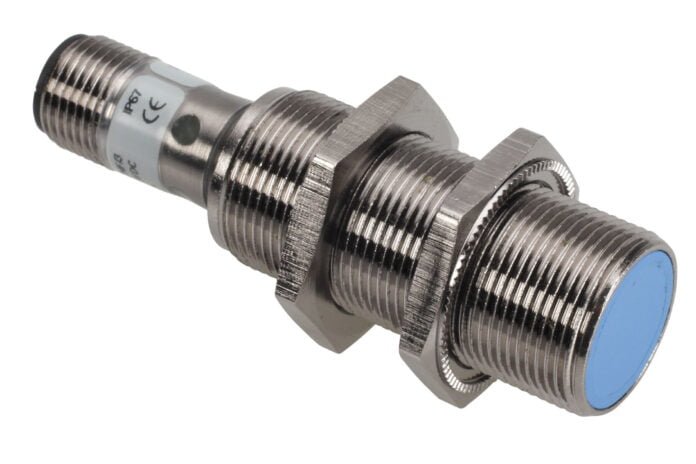An inductive sensor is a type of proximity sensor.
What does proximity sensor mean? Proximity sensor means – if any object comes into its vicinity, it senses that object.
What is an Inductive Proximity Sensor?
An inductive sensor is a non-contact type of sensor, helpful in the detection of metallic objects. It can sense ferrous as well as non-ferrous materials. The sensing range is up to 100 mm. However, the level of sensitivity defers while sensing non-ferrous material. Look at the table below.
| Sensitivity when different objects are present, Sn = Operating distance | |
| Fe37 (Iron) | 1 x Sn |
| Stainless Steel | 0.9 x Sn |
| Brass bronze | 0.5 x Sn |
| Copper | 0.4 x Sn |
| Aluminum | 0.4 x Sn |
The IEC symbol is –
 Let me tell you that inductive sensors work best with ferrous material.
Let me tell you that inductive sensors work best with ferrous material.
Why there is a need for a contactless sensor?
We already have mechanical switches available for position detection then what is the use of contactless sensors? This question may arise in your mind.
Contactless sensors have certain advantages that cannot be ignored.
Remember that mechanical switches have their advantage which can be talked about separately.
So, before I move on to the technical aspect of it, let me tell you some key features of inductive sensors.
- First of all, mechanical switches are contact detection switches. This means if the objects get in touch with the switch only then it will operate. This is not the case in the inductive sensor.
- You have to calculate and set the angle of approach in the case of mechanical switches.
- Wearing out of mechanical parts is the major issue that is not in the case of an inductive sensor. Inductive proximity sensors have solid-state assembly – no moving parts.
- Increase in maintenance time due to the replacement of worn-out parts.
- Actuators made are generally metallic which are subject to corrosion.
Main Components of Inductive Proximity Sensor
An inductive proximity sensor consists of four elements – the coil, the oscillator, the trigger circuit, and an output.
 Coil
Coil
The coil generates the necessary electromagnetic field. Cup-shaped ferrite magnetic core holds the coil inside. The cup-shaped core is necessary to concentrate the coil magnetic field on the front area of the sensor.
Oscillator
The oscillator is generally an LC oscillator. It produces radio frequency (100 kHz to 1 MHz) which helps to generate an electromagnetic field.
Trigger Circuit
The trigger circuit senses the change in amplitude of oscillation and gives the signal to solid-state output.
Output Circuit
The output circuit has a transistor NPN or PNP. After receiving the gate signal, the transistor switches ON and gives an output.
Working Principle of Inductive Proximity Sensor
 When a metal target enters the magnetic field created by coil, eddy current circulates within the target. This causes load on the sensor which decreases the oscillator’s amplitude. As the target reaches close to the sensor further the oscillator’s amplitude decreases.
When a metal target enters the magnetic field created by coil, eddy current circulates within the target. This causes load on the sensor which decreases the oscillator’s amplitude. As the target reaches close to the sensor further the oscillator’s amplitude decreases.
 The trigger circuit is normally a Schmitt trigger. It monitors the amplitude of an oscillator. If the oscillator’s amplitude reaches a predetermined level, the trigger circuit gives the signal to the output circuit to switch-ON the output.
The trigger circuit is normally a Schmitt trigger. It monitors the amplitude of an oscillator. If the oscillator’s amplitude reaches a predetermined level, the trigger circuit gives the signal to the output circuit to switch-ON the output.
Construction of Inductive Proximity Sensor
The sensing face can be of PEEK, Ceramics, etc. depending on the application requirement. You have various options in selecting the housing material. The selection of housing material is based upon the environment where it is going to be exposed. I am mentioning few housing materials:
- Stainless Steel V2A,
- Nickel-plated or Teflon-coated brass,
- PBTB (polybutyleneterephthalate)
- PPS
- PA (Polyamide)
High-grade stainless steel is the best option for hygienic areas. It can comply with food-grade standards.
The PBTB material is resistant to abrasion, heat and cold, etc.
The PPS material can withstand higher temperatures. The material can withstand 200 °C temperature.
The electronic circuit is resin-potted in a vacuum.
The cable material options are –
- PVC: Medium resistant to oil, grease, and highly resistant to abrasion.
- PUR: Gives high resistance to oil, grease. It is non-brittle and highly resistant to abrasion.
- Silicon: This material can withstand high temperatures (-50 °C to + 180 °C) but is medium resistant to oil and grease.
Application of Inductive Proximity Sensors
Inductive sensors are used in various applications. I am mentioning a few of them.
- You can use an Inductive proximity sensor to count the metal cans.
- Can be used to monitor the rotational speed of the machine.
- In conveyor application, you can use it to monitor the position.
- In a pipe manufacturing plant, the sensors are best for metal pipe detection for further processing of pipe.
- Robotic arm control is possible with the help of inductive sensors.
The monitoring and counting can be done without actually touching the target. That is the biggest advantage.
Advantages of Inductive Proximity Sensors
- Contactless sensing.
- High switching rate.
- Long-life as no moving parts are there.
- Easy installation.
Disadvantages of Inductive Proximity Sensors
- Can sense only metal.
- Range detection limitation. The maximum detection range is 100mm.
So, this is all about an Inductive proximity sensor. I hope you have found this article interesting.









Very interesting
Thanks
Nicely written. Thank you.